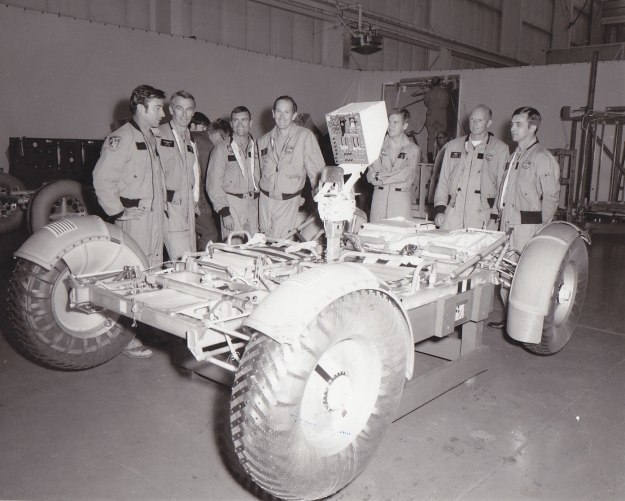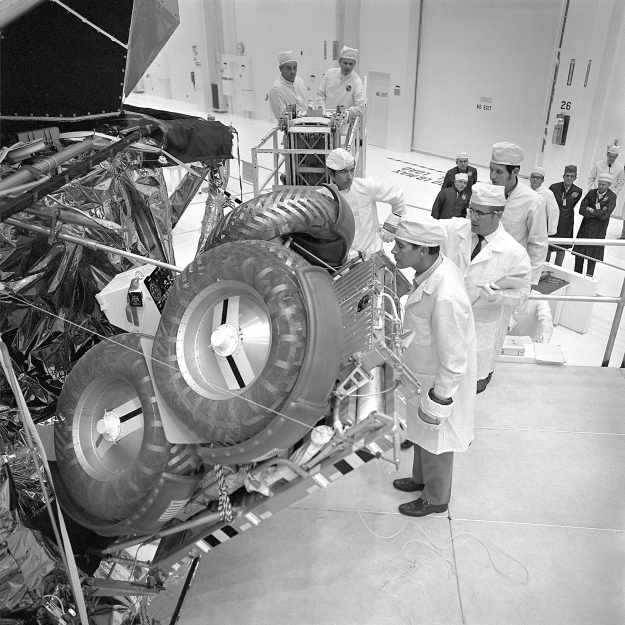The story of the creation of the lunar rover

In 1964, NASA began to think about sending astronauts to the moon, as well as which surface probe to send with them. The first options were ridiculous and strange, but in 1969, scientists seriously took up the development of the moon rover for the Apollo mission. And in less than two years, he was on the moon.
First rovers
NASA scientists from the George Marshall Space Flight Center were the first to think about sending astronauts to the moon. It was obvious that a special device would be needed, which would help in the study of the satellite. The main contender was a three-ton transport project, with a closed cabin for two people and a maximum speed of up to 100 (!) Kilometers per hour, which made it possible to study a large area. Called the project MOLAB.
')

Some engineers went further: in the future they offered to enable such devices to walk, crawl, jump and even fly around the moon. The idea of having a crew in the lunar rover was not implemented until 1969. On April 7, a little more than three months before the start of the Apollo 11 mission, Wernher von Braun set up a team to develop a lunar rover, the Lunar Roving Task Team, at the Marshall Space Flight Center.
At the beginning of work, von Braun admitted that the presence of such vehicles among astronauts will significantly complicate the launch of the mission - the weight of additional equipment will increase, and therefore the cost and risks of the project will increase. But at the same time, the head of the team noted that with the help of a lunar rover, astronauts would be easier to explore the surface of the moon - riding a rover is much more convenient than moving in bulky space suits.
"
The project could not be completed on time, by the launch date of the Apollo 11, but the authors believed that their lunar rover would be used in the following Apollo missions.
Development of a lunar rover
In early 1970, NASA signed a contract with Boeing to create a lunar rover. In the course of the work, it became clear that the rover would not be a full-fledged mobile laboratory, having only minimal research functionality. In addition, the project was complicated by the fact that there is no atmosphere on the moon, large temperature differences, a weak attractive force and an unknown surface. Therefore, the rover had to be powerful, heavy and reliable.

The device and characteristics of the lunar rover
The weight of the device was 210 kg, carrying capacity in terms of lunar attraction - 490 kg, length - 3 m, wheelbase - 2.3 m. The rover was powered by two 36-volt non-rechargeable silver-zinc batteries, which were equipped with a passive cooling system. Each wheel had its own engine, which saved the unit from switching speeds. The wheels could turn, so the turning radius was only three meters. In addition, the rover could overcome obstacles in the form of stones up to 70 cm in diameter. The tire was made of braided steel wire, which minimized the possibility of getting stuck in the lunar soil.

So that the crew did not get lost in an unfamiliar area, the rover had a navigation system that consisted of a gyrocompass and an odometer, as well as a device for determining the azimuth of movement in the shadow of the pin-gnomon . In general, the navigation system allowed astronauts to orient themselves on the surface of the moon relative to some point of reference, for example, the landing site. In addition, NASA from the Earth could track the movements of the Lunokhod: a highly directional reticulated parabolic antenna and a non-directional antenna were used for communication. A color television camera and a 16 mm movie camera, as well as a 70 mm camera were installed on board. The thermal protection system did not allow high temperatures to affect the equipment.
The first lunar rover in 1971, the mission "Apollo 15":

Human factor
One of the main questions remained: can astronauts in bulky space suits and under the conditions of the lunar force of gravity drive a rover? To answer this question, NASA engineers conducted numerous tests and experiments simulating the conditions of the lunar surface on Earth. Astronauts who helped improve the rover also participated in the design refinement process: for example, safety belts were added and more comfortable seats for the crew were designed.

On the moon
For transportation, the rover was attached to the landing stage of the lunar module. Assembly process:

For the first time the moon rover was on the moon during the Apollo 15 mission. July 31, 1971. Astronauts Dave Scott (Dave Scott) and Jim Irwin (Jim Irwin) gently lowered the rover to the surface, simultaneously checking the performance of all nodes, then automatically turned the wheels. After that, the astronauts could only mount the crew seats. The process was watched live by the NASA control center.

Thanks to the rover, astronauts could move far more away from the lunar module: during the Apollo 17 missions, the unit was up to 7.6 km from the landing point, unlike the “foot” missions, when astronauts retreated only one and a half kilometer. In addition, with the help of a rover various samples of lunar soil were collected.
Interesting Facts
During the second lunar expedition Apollo 17, Eugene Cernan (according to other sources, Harisson Schmitt, a geologist of the expedition) carrying a hammer in the suit pocket, accidentally hooked him with the handle of the “moonrover”, as a result of which it almost fell off; this small (by earthly standards) problem has become very significant for astronauts.
During the “Lunarover” movement, a lot of dust was raised, and with a broken wing, dust got on both spacesuits and vehicle elements, and since the dust is almost black, this created conditions for overheating (it’s not for nothing that the space suits are made in white colors). NASA engineers worked all night to solve the problem, and in the morning they informed the astronauts of the instructions, as a result of which the wing was taped.
UPD: kbtsiberkin added a photo of the wing sealed with tape and a set of cards ( Source ):

Links
- Article Not too long ago, astronauts roved the Moon
- Details about the project MOLAB
- Lunar car on Wikipedia
- Details about TTX rover

Source: https://habr.com/ru/post/189664/
All Articles